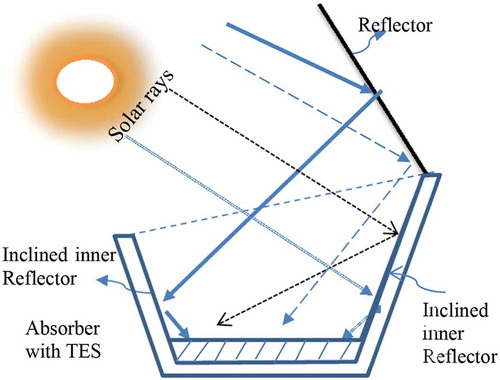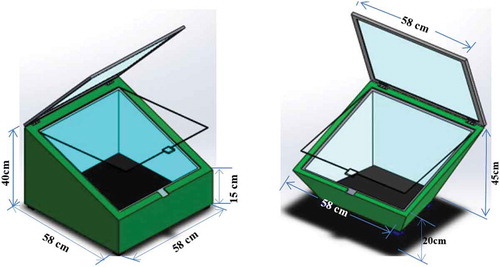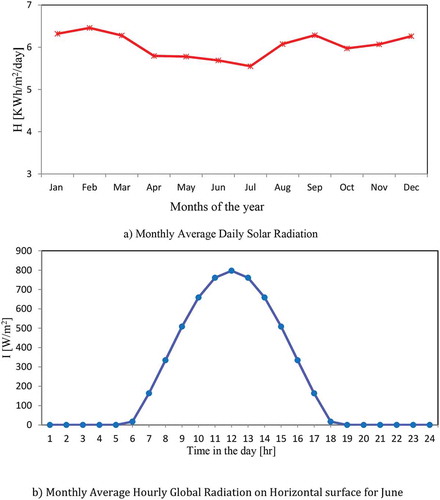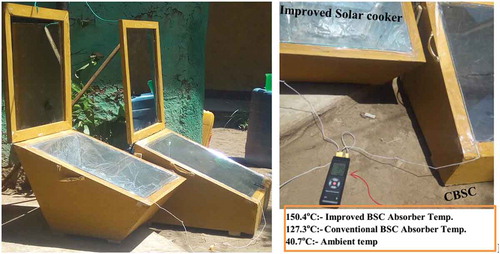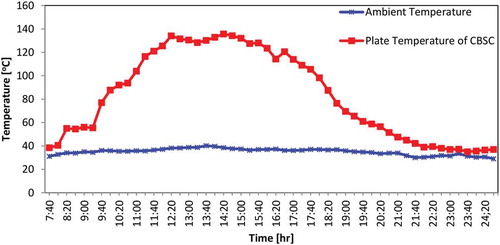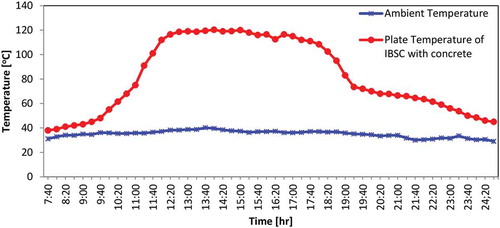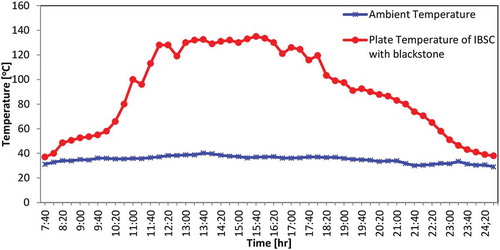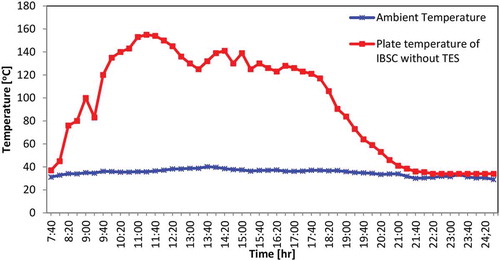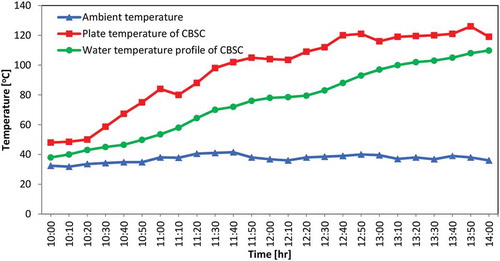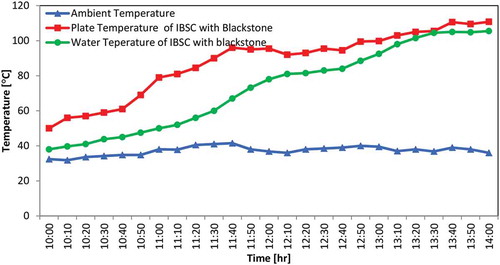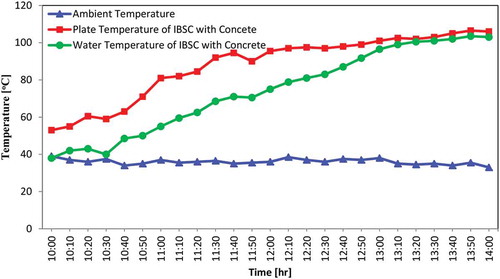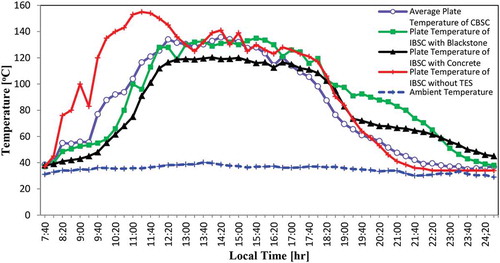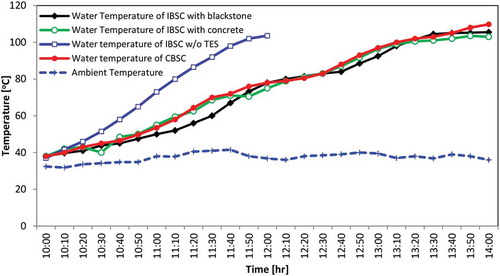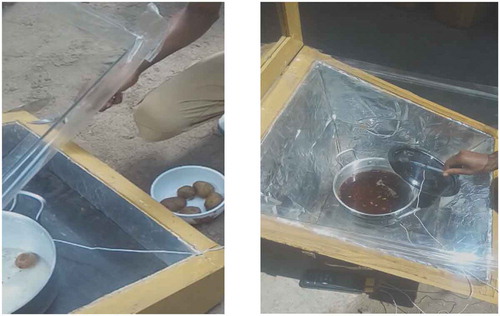 ?Mathematical formulae have been encoded as MathML and are displayed in this HTML version using MathJax in order to improve their display. Uncheck the box to turn MathJax off. This feature requires Javascript. Click on a formula to zoom.
?Mathematical formulae have been encoded as MathML and are displayed in this HTML version using MathJax in order to improve their display. Uncheck the box to turn MathJax off. This feature requires Javascript. Click on a formula to zoom.ABSTRACT
The main aim of this work is to design, develop and experimentally test the performance of an improved box-type solar cooker with thermal energy storage. The improvement features are the ability to concentrate solar rays and store thermal energy. The improved solar cooker became 20% less in inner surface area compared to the conventional solar cooker for the same intercept area of the sun. Experiments are conducted for stagnation test and load test followed by comparison of the thermal performance of improved solar cooker with conventional one. The performance testing parameters are used as per the Indian standard for box type solar cooker. Testing results showed that the averaged first figure of merits (F1) is 0.115 for conventional and, 0.1349 for improved solar cooker with black stone as a thermal energy storage, 0.1238 for improved solar cooker with concrete as a thermal energy storage and 0.1453 for improved solar cooker without any thermal storage. As per the Indian standard for testing of box type solar cooker, the improved box-type solar cookers in all condition are found to be grade ‘A’ due to the fact that the first figure of merits (F1) is greater than 0.12. Also the thermal energy storage materials used gives a remarkable storing capacity.
Introduction
This study is conducted at an area known as Omorate (Daassanech). Daassanech is one of Ethiopian district administrations that named after inhabitant ethnic groups, traditionally they are Nomadic pastoralists. It is a wide remote area located in southern part of Ethiopia, about 780 km far from the capital city, Addis Ababa, near to the boarder of both Kenya and South Sudan.
The geographic coordinates of selected site, Omorate (Dassenech), is:
Latitude: 4°49′59″ or 4.83333° N
Longitude: 36°06′00″ or 36.10° E
Elevation above sea level: 367 m.
Since Daassanech is a very remote location, and all domestic energy needs are achieved by biomass only the people are suffering from so many problems related to health, environment and other social problems.
A solar cooker is a device that utilise the sun’s radiation as an energy source to cook food, boil water and sterilise medical instruments. By using solar cooker it is possible to save time, cost and energy compared to the traditional biomass ovens. Likewise healthy problems resulting from indoor air pollution caused by biomass combustion, deforestation for fire wood and other related traditional biomass cooking problems can be reduced.
The main classifications of solar cookers are: box-, panel- and parabolic-type solar cookers. Often conventional box-type solar cookers are designed for the purpose of warming or heating food. For example, the solar cooker developed by Nandwani (Citation2014) was promoted as Solar Food Warmers for schools in Costa Rica.
To improve its performance box-type solar cookers have been modified in different ways in the different country. Some of those modifications are reviewed as below.
Sethi, Pal, and Sumathy (Citation2014) presented optimally inclined box-type solar cooker with single booster mirror along with design and development of a novel parallelepiped shaped cooking vessel design for efficient cooking. Abu-Malouh, Abdallah, and Muslih (Citation2011) has studied the effect of two axes automatic tracking on a solar cooking system. Achamyeleh et al. (Citation2017) designed and tested two major solar cookers, aluminium plated and black coated boxes. Theoretical and practical comparison was conducted to choose which cooker give the best efficiency with the same working environment. Mohammed, Rumah, and Abdulrahim (Citation2013) developed and tested the performance of a truncated pyramid solar thermal cooker in Nigeria. During testing, the highest plate stagnation temperature achieved to be 145°C, under no-load condition and reflector covered with black cloth. In full-load condition the temperature of 5.2 kg of water inside the cooker raised from 60°C to 90°C in 72 minutes. The First Figure of Merit was calculated to be 0.120 and the Second Figure of Merit was found to be 0.410.
Tekle (Citation2014) designed, prototyped and experimentally evaluated performance of low-cost inverted Pyramid shaped box-type solar cooker in Hawassa University, Ethiopia. Experimental testing has been taken based on standard of thermal test procedures for box-type solar cookers, by Mullick, Kandpal, and Saxena (Citation1987). But the system he designed should track the sun frequently, per 20 minutes.
Tekle (Citation2014) conducted one-year survey under the support of Japanese ODA to investigate the possibility of their newly developed durable and powerful panel-type solar cooker being used in the Federal Democratic Republic of Ethiopia as one of the heat sources for cooking. They conducted two field researches its outcomes revealed that almost all of the local typical food in Ethiopia can be cooked with solar cooker and 80% of the community members give positive feedback on the product.
Solar cookers with thermal storage
All solar cookers, like any other solar powered systems, can use thermal energy storage material to increase system performance. Specially, an indirect-type solar cooker uses thermal storage as a common unit of the system. TES is also used in box type and other concentrator-type solar cookers. The main purpose of thermal storage for solar cooker is to hold extra amount of heat and to balance the heat usage over the day in daily variation or over the year for seasonally varying incident.
Several works are carried out by researchers on phase change materials (PCM) integrated solar box cookers. Buddhi and Sahoo (Citation1997) has designed and fabricated box-type solar cooker with latent heat storage for the composite climatic conditions of India. The experimental results demonstrate that it is possible to cook the food and provide a nearly constant plate temperature even in the evening with a solar cooker having latent heat storage. They also compared experimental results with those of a conventional solar cooker.
Many research works have been conducted with experiment by using different sensible thermal heat storage materials. Shrestha and Byanjankar (Citation2007) investigated the effect of using stone pebbles as thermal energy storage. A thermal performance of box-type solar cooker with stone pebbles inside the cooker was tested with methodology described in ASAE international test standard. For the comparison, the cooker was put to test without stone pebbles, with uncoated stone pebbles and with black coated stone pebbles.
Saxena and Karakilcik (Citation2017) have developed box-type solar cooker with low cost thermal energy storage for the thermal performance evaluation. A mixture of sand and granular carbon with an optimum ratio was used as sensible thermal energy storage in solar box cooker (SBC). The experimentation procedure was conducted under climatic conditions of Moradabad, India. The results indicated that the first Figure of merit (F1) was 0.13, second Figure of merit (F2) was 0.44, thermal efficiency was estimated to be 37.1%, and cooking power was estimated as 44.81 W. Then the system was found feasible for cooking during the off sunshine conditions.
Cuce (Citation2018) experimentally analysed box-type solar cookers with and without thermal energy storage under Bayburt climatic conditions, Turkey. He used Bayburt stone, a special natural stone with low density and notably high specific heat capacity, to utilise as a sensible thermal energy storage medium in a cylindrical box-type solar cooker and compared thermal performance assessment of Bayburt stone cooker with a conventional cooker without thermal energy storage through a comprehensive experimental research and thermodynamic analysis. Energy efficiency of Bayburt stone cooker is found to be in the range of 35.3–21.7% while it is 27.6–16.9% for conventional solar cooker. Finally, he concluded from the results that Bayburt stone as a TES medium remarkably improved the thermal performance figures of box solar cookers.
Even though so many research works have been done in this area, still there is a wide research gap to fulfill societies need and to design socially acceptable solar cooker for the specific site. So in this work partially concentrating box-type solar cooker with locally available thermal energy storage material is designed, fabricated and tested in remote area of Ethiopia.
Thermal modelling of box-type solar cookers
Description of the solar cookers
As shown in below both inner wall and outer reflectors direct sunrays in addition to beam and diffuse solar energy to black painted absorber with TES. Because black makes sure, the incoming sunlight is absorbed and metal easily conducts the heat to the food inside the pan or TES under plate.
Solar intercept area of this solar cooker is 50 × 50 cm2 with inclined glazing glass and 4 cm thickness of plywood and inset fibre natural insulation has been used. Detail dimensions has been presented in .
Box-type solar cooker model
Losses through bottom and side (wall) can easily calculate from the following equation:
The top loss coefficient Ut can be calculated from the empirical equation by following the basic procedures of klein (1979) as given in Duffie and Beckman (Citation2006):
Where:
wind heat transfer coefficient (
)
εp is emittance of absorber plate
is wind speed [m/s],
N is number of glazing, is absorber slope
The absorber plate temperature at any time (t+∆t) can be obtained from energy balance of absorbed by and loss from the cooker chamber. The energy balance equation of cooker chamber is:
Without load the plate temperature will be:
Where: is the product of mass and specific heat capacity of the absorber plate.
where is absorber plate tmeperature at time, t
is absorber plate tmeperature at time, t + Δt
is transmitivity of the glass
is absorpitivity of the absorber plate
Similarly, the water temperature at any time (t+∆t) can be calculated from energy balance of water in the pot as follows.
where, – is the water tmeperature at time, t
– is the water tmeperature at time, t + Δt
– sum of the bottom and side area of the pot
– top area of the pot
– is the mean pot temperature
– is heat loss coefficient from the water to the ambient
– is heat transfer coefficeint from the pot surface to the water
Figures of merits
First figure of merit is based on a stagnation test cooker box without any load, defined as the ratio of optical efficiency to the heat loss coefficient ατ/UL as follows:
Where:
τ – transimittance of the glass
α – absorptance of the cooking tray
UL – heat loss coefficient of the cooker, and
Hs – solar radiation on the aperture plane of the box-type solar cooker during steady state
Second figure of merit is computes from a load test that follow water boiling test procedure for the thermal performance evaluation of a solar cooker.
Where:
F1 – first figure of merit from stagnation test
– product of the mass of water and specific heat in J/
Ag – aperture area of the cooker cover plate in m2
t – time taken for heating from to
in seconds
– average air temperature over time period t in
H – average solar radiation over time period ti W/m2
Solar radiation power is calculated by using based on well-known Angström model which was modified latter by Prescott (Citation1940) and Page (Citation1961). An average solar radiation is calculated as maximum in February (6.563 KW/m2/day) and minimum in July Month (5.578 KW/m2/day) and Annual Average daily solar radiation is 6.134 KW/m2/day.
Required thermal energy to raise water from 30°C to 93°C,
Required energy rate for cooking ()
Energy loss by evaporation ()
Energy loss through insulation and glaze ()
Total power required
Minimum aperture area of the cooker (Ag),
Considering the standard for full load testing which is 8 kg/m2 of collector area as per IS 13429 (Part 3) Citation2000, a 2 kg load is selected for the solar intercept area of 0.25 m2.
Solar radiation estimation
Global solar radiation based on Angström-prescott model is described as follows (Bekele, Alemu, and Mishra Citation2013):
… … … … … … … … … … … … … … … … … … … … … … … … (8)
Where:
= monthly average daily radiation on horizontal surface
= monthly average daily extraterrestrial solar radiation outside the earth atmosphere
= monthly average daily hours of bright sunshine
= monthly average of maximum possible daily hours of bright sunshine
The monthly average daily hours of bright sunshine data for Omorate are obtained from the Ethiopian National Meteorological Agency and tabulated as .
Table 1. Monthly average daily hours of bright sunshine ()
Based on the above equations the monthly average daily solar radiation for Omorate () is estimated as maximum in February (6.458 KW/m2/day) and minimum in July Month (5.55 KW/m2/day) and annual average daily solar radiation is 6.134 KW/m2/day.
The daily average hourly global radiation on a horizontal surface () can be determined from: (Bekele, Alemu, and Mishra Citation2013)
Where:
is sunset hour angle
is hour angle
(a) Monthly average daily solar radiation
(b) Monthly average hourly global radiation on horizontal surface for June
Experimental setups
In order to construct improved solar cooker, the selected materials are low cost, locally available and able to withstand high temperature (). The details materials and their properties are given in below.
Figure 4. (a) Black stone used as TES and (b) concrete used as TES, (c) ‘Inset’ fibre used as insulation

Table 2. Materials used for construction of IBSC
Table 3. Physical properties of TES materials
Enset is one of the main indigenous drought resistant crops in Ethiopia. It contributes to food security for more than 20% of Ethiopia’s population [Zerihun Citation2014]. It is physically like banana plant, thus it is called sometimes ‘false banana’ but unlike banana except seed and leaf all other parts are edible and it has no edible fruits.
As shown in both cookers have the same collector area but improved solar cooker has 5 cm additional height to hold TES material and its absorber area is smaller than the conventional solar cooker.
Instruments used during experimental testing are k-type thermocouple with four channel digital thermocouple reader and weighting scale. Thermocouples has been calibrated before it is used for testing by using laboratory standard calibrator of ± 0.1% accuracy and obtained a maximum uncertainty of 0.42%.
The total inner surface area including absorber plate, for conventional solar cooker and for improved one is calculated as 0.8 m2 and 0.64 m2, respectively and this shows the improved solar cooker became 20% less in inner surface area. The experimental data was conducted for stagnation test, load test and cooking test between June 1015, 2019 and the result is explained as below.
Result and discussion
Stagnation test
As it can be seen from to 9 the stagnation (no load) test is carried out from sunrise to sunset and continued up to the midnight for investigating the effect of thermal storage. The plate temperature is observed to increase from sunrise to noon due to the increase of solar insolation and nearly constant till 3:00 PM then after declined up to the sunset following the decrease of solar insolation.
After the sun set the plate temperature continued to decrease due to the heat loss from the cooker to the ambient. Here it is observed that for the case of CBSC () and IBSC without thermal storage () the plate temperature has almost dropped down to the ambient temperature. Whereas for IBSC with thermal energy storages () even though the plate temperature similarly dropped due to heat loss to the ambient it is still significantly higher than the ambient temperature up to the mid night and this show the capacity of the cooker to warm food even in the absence of sun due to the stored thermal energy.
Load test
The load tests have been conducted for both conventional and improved ones starting from 10:00 AM local time. As it can be seen from the graphs of the water temperature increase very slowly after 100°C due to the occurrence of a film of water vapours as a result of phase change and covers the inner surface of transparent glass cover increasing the thermal resistance to the radiation absorption.
During the load test for the case of an improved box-type solar cooker without any thermal energy storage () the water temperature has attained a temperature above 100°C within in 2 hours. Initially water was at 37°C and after 2 hours it has become 101.5°C, so averagely it increased 5.375°C per each 10 minutes (0.5375°C/minute).
Comparisons of temperature distributions
Comparison is presented for box stagnation and load tests in . As seen in an improved box-type solar cooker without thermal energy storage has absorbed greater solar radiation and its absorber plate has attained a maximum temperature of 155°C while maximum temperature attained by conventional solar cooker is about 139°C. Also it is observed that the plate temperature of an improved box-type solar cooker without TES is highly fluctuating with solar intensity. During day time the absorber plate temperature of an improved box-type solar cooker with concrete as a TES is seen to be the minimum among all because the solar radiation absorbed by the plate has transferred to the concrete (i.e. high heat loss from the absorber plate to the concrete). During night time (when there is no sun) it is seen that cookers with TES diffuses remarkable heat which can warm food.
As described in the load tests were started at 10:00 AM with initial water temperature of 38°C and absorber plate temperature above 46°C for all cookers. With increase in time it is observed that the absorber plate and water temperature in the conventional box-type solar cooker is higher than that of an improved box-type solar cooker with TES. This is because in an improved box-type solar cooker with TES there is an additional load due to a black stone and concert in the system which is being used as TES and hence it absorbs heat from the absorber plate and reduces the useful energy to be used for water heating.
Cooking test
Cooking test has been conducted on 15th of June 2019 for 0.5 kg of potato (left)) with one litre of water added and Shoforo drink (right)) with two litres of water added. The IBSC without TES cooked the potato in 50 minute, IBSC with black stone as TES took 80 minutes to cook and the CBSC has taken 110 minutes to cook the same amount of potato. The Shoforo was cooked using the IBSC without TES and it was cooked enough to drink after 80 minutes.
‘Shoforo’ is a marvellous cultural hot drink in Daassanech; it is a broth of coffee husk, made by infusing coffee husk in boiling water to cook it, and be ready for drink by extracting its broth.
The stored thermal energy can be used for warming a food and this is demonstrated in for warming a 2 kg of Shoforo drink as follows:
Mass of the storage material (Blackstone) = 6.25 kg
Required warming temperature of Shoforo drink,
= 45 °C.
The initial temperature of Shoforo drink = ambient temperature
Energy required for warming a Shoforo drink =
Usable stored energy =
Energy stored =
Table 4. Demonstration of stored energy and energy required for warming a Shoforo drink
The result shows that for a time period of 18:00–22:00 hrs, the heat energy required to warm a Shoforo drink from ambient temperature to 45°C is higher than the usable stored thermal energy. Thus, the stored energy can be used for warming a food.
Figures of merits
The experiments have been conducted following the Indian testing standard procedures which is proposed by Mullick, Kandpal, and Saxena (Citation1987) and approved by Bureau of Indian Standard (BIS). As per this standard (IS 13429 (Part 3) Citation2000) two figures of merits of (F1 and F2) are used as thermal performance parameters. Load and no-load (stagnation) tests have been conducted.
For the conventional solar cooker the theoretical analysis gives the first (F1) and second (F2) figures of merits equal to 0.116 and 0.553 respectively, whereas the corresponding experimental result gives F1 = 0.115 and F2 = 0.524. This shows there is a good relationship between theoretical and experimental analysis of the solar cooker performance
The average experimental value of the first figure of merits (F1) is 0.1349 for improved BSC with Blackstone as TES, 0.1238 for improved BSC with concrete as TES and 0.1453 for improved BSC without any thermal storage, respectively. A high value of F1 indicates good optical efficiency and low heat loss factor from the absorber plate.
The average experimental value of the second figure of merits (F2) is 0.97 for improved box solar cooker with black stone as TES, 0.865 for improved box solar cooker with Concrete as TES, and 1.0964 for improved box solar cooker without any TES respectively. A high value of F2 shows cooker has good heat exchange efficiency factor, good optical efficiency, and low heat capacity of the cooker interiors and pans compared to a full load of water.
Both the first figure of merits (F1) and the second figure of merits (F2) for improved box-type solar cookers with thermal energy storage are less than that of an improved box-type solar cooker without thermal energy storage. This is due to the fact that a part of thermal energy is transferred from the absorber surface to the storage system for later use when there is no sun.
Comparison of the present work with previous works
The comparisons of the present work with similar previous works done by different researchers are summarised as given in the .
Table 5. Thermal performance comparison of the present study with the previous researchers work
The work presented by Shrestha and Byanjankar (Citation2007) is conventional BSC with stone pebbles and Tekle (Citation2014) designed and prototyped modified-type solar cooker with trapezoidal glazing surface. According to the results described in this work, an improved box-type solar cooker with TES is better than the works of Tekle (Citation2014) and Shrestha and Byanjankar (Citation2007). For instance in this work the maximum temperature obtained without stone pebble is about 130°C; in this work also conventional BSC maximum no-load temperature is 145°C. This much difference is revealed due to the difference of volume of cookers. The first and Second figures of merits are 0.19 and 0.55 for Shrestha and Byanjankar (Citation2007) work, in this work it is 0.115 and 0.524 respectively.
The improved box-type solar cooker of the present study shows a higher value for the second figure of merits when compared with Tekle (Citation2014) and Shrestha and Byanjankar (Citation2007) and this shows the cooker has better heating capacity.
Conclusion
From the present experimental study the following conclusions can be drawn:
The Improved box-type solar cooker with/without thermal energy storage is found to be better than conventional box-type solar cooker.
It is observed that locally available materials such as black stone and concrete as sensible thermal energy storage and ‘Enset’ fibre as an insulation and wood as a frame can be used for the construction of box-type solar cooker with remarkable thermal performance.
The experimental test results showed that the maximum no-load absorber plate and full-load water temperatures are 155°C and 110°C respectively. In an improved box-type solar cooker without TES the water boiled in less than two hours whereas in another cookers it take up to three hours.
As it is seen from the experimental results, though an improved box-type solar cooker without TES is better than all other solar cookers to fast cooks in daytime, improved solar cooker with TES is able to store thermal energy to utilise it in evening. Also it makes uniform heat energy supply to the water with naturally fluctuating solar energy.
Improved solar cooker with square solar intercept area which has 5 cm additional height to hold thermal storage material has 20% less size than the conventional solar cooker inner area for the same intercept area of the sun. Thermal efficiency comparison is done for the same aperture area of conventional and improved box solar cooker but if the same absorber area is used an improved solar cooker can absorb much solar energy and it can have a wide space to hold additional thermal storage materials.
The thermal energy storage used will help the cooker to warm a food even when there is no sun in the night. Of course the amount of thermal energy stored depends on the storage material type and size.
Nomenclatures
Table
Additional information
Notes on contributors
Ephrem Milikias
Ephrem Milikias is a lecturer in Dilla University, Dilla - Ethiopia, since Sep. 2016. He received a Bachelor of Science Degree in Mechanical Engineering from Arbaminch University, Arbaminch – Ethiopia in June 2016 and Master of Science Degree in Thermal Engineering from Adama Science and Technology University, Adama - Ethiopia in July 2019. His research area is Renewable Energy.
Addisu Bekele
Dr. Addisu Bekele was born in Ethiopia on 10th May 1985. He Completed B.Sc. Degree in Mechanical Engineering in 2004, from Bahir Dar University, Bahir Dar-Ethiopia, M.Sc. Degree in Mechanical Engineering (Thermal) in 2007 from Addis Ababa University, Addis Ababa-Ethiopia and PhD Degree in Thermal Engineering in 2012 from Indian Institute of Technology Roorkee, Roorkee-India. He has published more than 17 articles on international Referred journals and on international and national conferences. His research areas are solar energy, wind energy, biomass, fluid flow and heat transfer, heat exchanger, numerical and computational analysis, refrigeration and air conditioning.
Chandraprabu Venkatachalam
Dr. Chandraprabu Venkatachalam was born in Tiruchengode, Namakkal (DT), Tamilnadu, India on 25th January 1977, Completed Bachelor of Engineering (Mechanical Engineering) in the year of 1999, completed Master of Engineering (Thermal Engineering) in the year of 2005 and completed PhD (Thermal Engineering) in the year of 2014. He has published 15 articles in international journal, 3 articles in international conference and 7 articles in national conferences. His research area is heat transfer enhancement in the air conditioning system using nano-fluids and solar energy.
References
- Abu-Malouh, R., S. Abdallah, and I. M. Muslih. 2011. “Design, Construction and Operation of Spherical Solar Cooker with Automatic Sun Tracking System.” Energy Conversion and Management 52: 615–620. doi:10.1016/j.enconman.2010.07.037.
- Achamyeleh, T., S. Ramu, S. Bantelay, and R. Srinivasan. 2017. “Experimental Comparison of Solar Cooker Using Black Coated and Aluminum Coated Box.” IIJME 5:007–012
- Bekele, A., D. Alemu, and M. Mishra. 2013. “Large Scale Solar Water Heating Systems Analysis in Ethiopia: A Case Study.” International Journal of Sustainable Energy 32 (4): 207–228. doi:10.1080/14786451.2011.605951.
- Buddhi, D., and L. K. Sahoo. 1997. “Solar Cooker with Latent Heat Storage: Design and Experimental Testing.” Energy Conversion and Management 38 (5): 493–498. doi:10.1016/S0196-8904(96)00066-0.
- Cuce, P. M. 2018. “Box Type Solar Cookers with Sensible Thermal Energy Storage Medium: A Comparative Experimental Investigation and Thermodynamic Analysis.” Solar Energy 166: 432–440. doi:10.1016/j.solener.2018.03.077.
- Duffie, J. A., and W. A. Beckman. 2006. Solar Engineering of Thermal Processes. Third ed. John Wiley & Sons, Inc., Hoboken, New Jersey
- Funk, P. A. 2013. International Standard for Testing Solar Cookers ASABE Standard S580. USA: USDA Agricultural Research Service.
- IS 13429 (Part 3). 2000. “Indian Standard for Solar Cooker – Box Type: Part 3: Testing Method.”
- Jaramillo, O. A., G. Huelsz, G. Hernández-Luna, J. A. Del Río, R. Acosta, and L. G. Arriaga. 2007. “Solar Oven for Intertropical Zones: Optogeometrical Design.” Energy Conversion and Management 48 (10): 2649–2656. doi:10.1016/j.enconman.2007.04.021
- Mohammed, I. L., U. J. Rumah, and A. T. Abdulrahim. 2013. “Performance Testing of a Truncated Pyramid Solar Thermal Cooker.” IJERA 3 (4): 1174–1178.
- Mullick, S. C., T. C. Kandpal, and A. K. Saxena. 1987. “Thermal Test Procedure for Box-type Solar Cookers.” Solar Energy 39 (4): 353–360. doi:10.1016/S0038-092X(87)80021-X.
- Nahar, N. M. 2003. “Performance and Testing of a Hot Box Storage Solar Cooker.” Energy Conversion and Management 44: 1323–1331. doi:10.1016/S0196-8904(02)00113-9.
- Nakajo, Y., S. Shuto, and T. Yamaguchi. 2014. Durable High Power Panel Type Solar Cooker and Its Effectiveness Study in Ethiopia.
- Nandwani, S. S. 2014. Solar Food Warmers for Educational Centers in Costa Rica. Sacramento (CA), USA: Solar Cookers International.
- Page, J. K. 1961. “The estimation of monthly mean values of daily total short wave radiation on vertical and inclined surfaces from sunshine records for latitudes 40°N-40°S”. In Proceedings of U.N. Conference on New Sources of Energy: 378 – 390
- Prescott, J. A. 1940. “Evaporation from water surface in relation to solar radiation.” Trans. Roy.Soc. Austr, 46: 114–118
- Saxena, A., and M. Karakilcik. 2017. “Performance Evaluation of a Solar Cooker with Low Cost Heat Storage Material.” International Journal of Sustainable and Green Energy 6 (4): 57–63. doi:10.11648/j.ijrse.20170604.12.
- Sethi, V. P., D. S. Pal, and K. Sumathy. 2014. “Performance Evaluation and Solar Radiation Capture of Optimally Inclined Box Type Solar Cooker with Parallelepiped Cooking Vessel Design.” Energy Conversion and Management 81: 231–241. doi:10.1016/j.enconman.2014.02.041.
- Shrestha, J. N., and M. R. Byanjankar. 2007. “Thermal Performance Evaluation of Box Type Solar Cooker Using Stone Pebbles for Thermal Energy Storage.” IJRE 2 (2): 11–21
- Tekle, A. 2014. “Experimental Assessment on Thermal Performance and Efficiency of Pyra-Box Solar Cooker.” Journal of Energy Technologies and Policy 4 (7): 58–65
- Uhuegbu, C. 2011. “Design and Construction of a Wooden Solar Box Cooker with Performance and Efficiency Test.” Journal of Basic and Applied Scientific Research 1 (7): 533–538.
- Yemataw, Z., Mohamed, H., Diro, M., Addis, T., and Blomme, G. 2014. “Enset (Enseteventricosum) clone selection by farmers and their cultural practices in southern Ethiopia.” Genetic Resources and Crop Evolution 61: 1091–1104. doi:10.1007/s10722-014-0093-6 6 61

